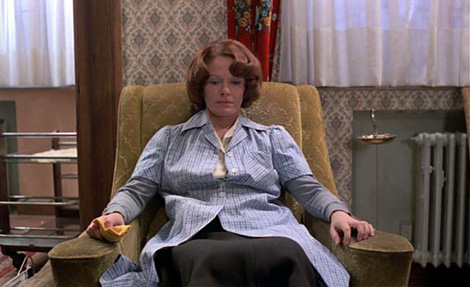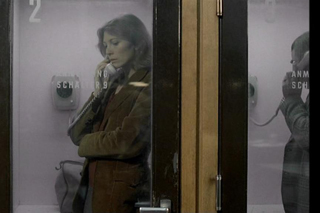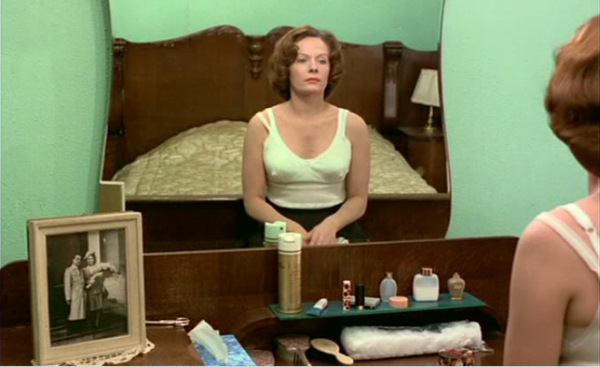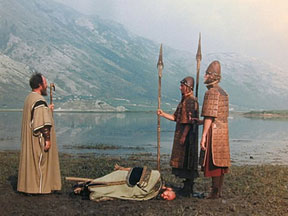From American Film (February 1979). This article was specifically conceived as a sort of sequel/companion-piece to “Aspects of the Avant-Garde: Three Innovators,” an article published in American Film almost half a year earlier. This plan was undermined in various ways by the editors, who gave it a title derived from a middle-class French comedy of the period (“Jean-Luc, Chantal, Danièle, Jean-Marie, and the Others”) that caused Akerman herself to reproach me for the piece (assuming that I’d dreamed up that title myself). I no longer recall what my original title was, but I’ve tweaked this piece in a few other minor ways to make it a little less unbearable to me. (By and large, most of my articles written for American Film qualified at least partially as hackwork done to pay my rent.) — J.R.
If American avant-garde films are often chancy to come by, even the most exciting European examples are apt to be regarded in this country as only distant legends. To cite one characteristic but scarcely isolated phenomenon: The welcome once given by the New York Film Festival to the works of Jean-Luc Godard and the team of Jean-Marie Straub and Danièle Huillet hasn’t been extended to any of their recent films, and none of the movies of Chantal Akerman has have ever been shown here. These fascinating filmmakers are far from being the only examples that spring to mind, but they do serve as representatives of a very wide area of European filmmaking that is flagrantly overlooked.
The most powerful and challenging innovative work in Europe that I’ve seen in the seventies hasn’t been visible in this country, except under the most limited circumstances. But the fact that Godard’s Numéro deux (Number Two),Straub-Huillet’ s Fortini-Cani and Every Revolution Is a Throw of the Dice, and Akerman’s Jeanne Dielman have all had respectable commercial runs in London and Paris doesn’t imply that European spectators are more intellectual than their American counterparts. It merely suggests that U. S. distributors are taking fewer risks.
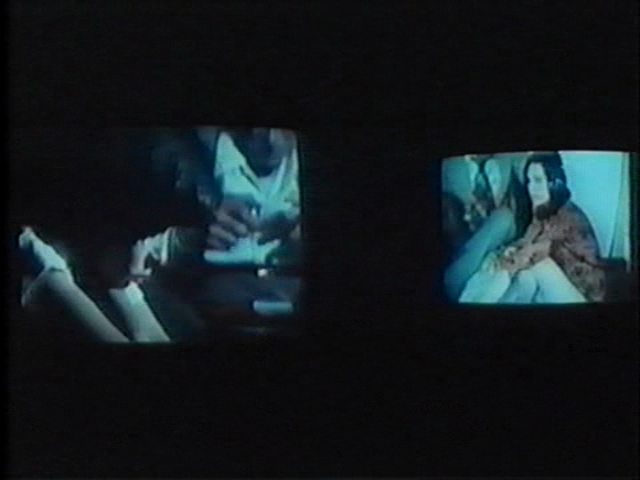
The personal commitment some distributors made to difficult films in the sixties has largely evaporated, helped along by the indifference of critics — some of whom, one could bet, would be happier if such movies didn’t exist. They want life to be as simple as the movies they write about; so that if any of these European films eventually gets released here, one would expect them to look the other way. And where does that leave the rest of us?
***
What ever happened to Godard?” I hear people ask wistfully from time to time. About a year ago in London, an influential American critic [2012 note: this was Andrew Sarris] assured me that no one, but no one, was interested in him any more. Had he seen any of Godard’s recent films? No, unfortunately, he hadn’t.
One critic, Gilberto Perez, drafted a virtual epitaph for the director in the October 1978 Artforum: “Godard. . . more boldly and broadly than anyone before him, took apart the diverse artifice of films while rescuing it for his purposes until, around 1968, he apparently decided it was beyond rescue. . . .”
If Perez is alluding to the films Godard made with Jean-Pierre Gorin between 1968 and 1972, it is easy to see what he means. There is a brittle intransigence to the political didacticism of these works that makes them seem more like self-administered lessons for the filmmakers themselves than statements for an audience, and most of them are already quite dated. Yet to my mind , Numéro deux, Ici et ailleurs (Here and Elsewhere), and Comment ça va? (How’s It Going?) — all made since, in collaboration-with Anne-Marie Miéville-are different matters altogether; and practically no one in America is getting to see them.
When I met Godard last summer in San Diego, where he was briefly vacationing, someone remarked to him that he must feel frustrated at not being as active as he was in the sixties. Godard expressed puzzlement. “But I’m just as active now as I was then!” Godard insisted. “I produce as much as I used to, even more, only you haven’t been able to see it!”
It’s all a matter of media and other tools of measurement. Godard still makes films and shoots long programs in video for French television (two, to be precise, running twelve and six hours each). Many other diverse projects — including a six-part history of the movies for television and a theatrical feature about gangster Bugsy Siegel — are reported to be in the works.
Yet to an alarming degree, the unavailability of his output is being equated and confused with the quantity and even the quality of his productivity. Apparently, economics defines existence for critics and spectators alike. As a consequence, our overall view of European cinema has been steadily shrinking during the past decade.
Chantal Akerman’s interest in film started when she saw Godard’s Pierrot le fou (Crazy Pete) in her native Brussels at the age of fifteen — lying about her age in order to get in. Another vital influence came from the films of Michael Snow, which she saw in New York in the early seventies. Still in her twenties, she has completed ten films, five of them features. Last year she won the best-director prize at the Paris Film Festival for Les rendez-vous d’Anna (The Meetings of Anna), her latest feature.
One way or another — in Edinburgh, London, Paris, San Diego, and New York — I’ve managed to see all her other features. One I’ve seen four times. Its full title is Jeanne Dielman, 23 quai de Commerce, 1080 Bruxelles — tracing out a total identity, complete with address and zip code. It stars Delphine Seyrig, was shot in 35mm and color by the talented Babette Mangolte, and runs for 205 minutes.
The film charts a two-day period in the life of a “proper” middle-class widow who supports herself and her teenage son by sleeping with men in the afternoons. Each time I’ve seen it, it’s given me something different to think about.
Moment to moment, it looks like hyperrealism, concentrated on such mundane events as housework, most of which is shown in full, without camera movement or cuts. When sex is finally shown as well, in the penultimate shot, it is immediately followed by the heroine’s murder of her customer with a pair of scissors. This, in turn, is followed by the longest shot in the film, which shows her thinking.
If all this sounds like an ordeal, it can easily become one — as long as one watches the film with a conventional set of expectations and labels (such as “narrative film,” “realism,” “housework drudgery, or “feminist tract”). The problem is that none of these categories adequately accounts for the shrewd game that Akerman is up to. Once we regard the screen not so much as a “purveyor of truth” but as a partner in a dialogue — and one that sees truth as a process, not a final destination — the film automatically becomes a spellbinder, because at every moment it’s offering something at once fresh and familiar.
Fresh, because the images themselves are ravishing painterly compositions, immaculately lighted and framed so that characters are seen either frontally or in profile, but from no intermediate angles — and because Delphine Seyrig, one of the finest French actresses, is giving one of the finest performances of her career. Familiar, because what she’s doing — mundane daily tasks and errands – is what we all spend a goodly portion of our lives doing, but seldom stop to think about or reflect on.
Jeanne Dielman is unconventional only insofar as it allows us to think while watching it — and obliges us to think if we want it to talk back. Patricia Patterson and Manny Farber have aptly noted that the film “suggests a workable parlance between the structural and commercial film.” On the structural side are the preoccupations with framing and duration that mark the movies of Snow and Warhol. Commercially, there’s the star performance of Seyrig and the crisp,35mm color images. Both could teach most commercial filmmakers a thing or two at the sametime that they undermine the very “realism” they initially appear to espouse.
***
A distinguishing characteristic of most European avant-garde filmmaking, in contrast to most American work, is the influence of a Marxist tradition, particularly the concepts of dialectics and materialism.
Dialectics — the notion that change takes place from the conflict of opposing forces –is basic to many of Akerman’s strategies. This is evident not only in the structural-commercial polarity of Jeanne Dielman, but also, for instance, in the split between sounds and images of New York City and Akerman’s offscreen voice reading letters from her mother in News From Home, her subsequent feature. There, the division renders the precise alienation of her foreigner status.
Dialectical thinking leads to the juxtaposition of documentary and fiction in Godard’s work, which has exerted, in turn, a discernible influence on Straub and Huillet. They also begin with a dialectic between past and present, history and politics, that keeps all their films perpetually posed around this issue.
Materialism, on the other hand — defined in an artistic context by the Concise Oxford as a “tendency to lay stress on material aspects of objects” — has a lot to do with the attitudes of all these filmmakers toward sound. Although their uses of sound differ in other ways, they all treat it as material separate from the image rather than as a standard supplementary ‘support,” the model provided by most commercial movies.
For Straub and Huillet, dialectics and materialism come together through the issue of how to represent works from the past in terms of the present. In their films these works have included fiction by Heinrich Böll; music by Bach; an unfinished novel by Brecht; plays by Ferdinand Bruckner and Corneille; an unfinished opera, a short musical piece, and two letters by Arnold Schönberg; an autobiographical political text by Franco Fortini; and a poem by Mallarmé.
Each work is recited or performed in its original language and in synchronized sound — which means that this dedicated couple have made films in German, French, and Italian. But none of the works assumes a precise national identity of its own; the stance of the filmmakers is always at one remove. Significantly, Straub was born in Lorraine and met Huillet in Paris in the mid-fifties. (They have been making films together for more than fifteen years.)
Straub-Huillet’s ” setting” of each work in filmic terms is always a critical interpretation of that work. Bruckner’s play, for example, is mercilessly reduced to elliptic fragments and set within a larger structure in their brilliant short The Bridegroom, the Comedienne, and the Pimp. In Moses and Aaron, the music and libretto of Schönberg’s opera are preserved intact, while his detailed stage directions are carefully subverted, placing the whole work in a different light. The opera is transferred to the open air, the singing recorded live to the orchestra’s playback; grandiloquent stage settings are translated into simple natural locations, and actor placements are reformulated as cuts or camera movements.
Some critics have compared these films to palimpsests — tablets that have been written on several times, with some residue of each use remaining. To some extent, the European settings are like “layered” tablets themselves, with the visible deposits left by different historical periods matching the filmmakers’ diverse critical perspectives.
Thus Moses and Aaron comments on three distinct periods in relation to one another: the time of the biblical events, the period when the opera was written (1933-52), and the mid-seventies, when the film was made. In Fortini-Cani, Straub-Huillet’s second feature with a Jewish theme — Fortini, an Italian Jewish poet, is shown reading from a short book, I cani del Sinai (The Dogs of Sinai), that he wrote ten years earlier, immediately after the Six-Day War between Israel and the Arab states. Settings that evoke the time of Italian fascism are also shown, while Fortini’s moving text recounts some of his own personal experiences during that period. Here again, all three periods interact and inform each other in the present, when we watch the film.
For me, these two films are the most accessible of Straub-Huillet’s features, if only because their verbal and musical works are directly expressive, eloquent, and relatively easy to follow. When the works are more intractable, the juxtapositions are likelier to seem jarring and comic — making the films not so much riddles to be solved as series of clashes and continuities to be reflected upon.
In their latest film, a pithy, eleven-minute short, an abstract, apolitical Mallarmé poem (“A Throw of the Dice Will Never Abolish Chance”) is declaimed by several men and women in succession. All of them are seated on a grassy hillside in Paris’s Père-Lachaise cemetery, reciting the poem as if it were a political declaration. Huillet herself, one of the group, even accompanies one passage with an impassioned Communist salute.
What’s the point of such willful eccentricity? The film’s title — “Every Revolution Is a Throw of the Dice, ” a quote from Michelet about the Paris Commune — offers one clue. In fact, several commune heroes are buried quite close to the grassy hillside. And to complicate matters further, the rooftops and television antennae of modern Paris are lingered over after the poem’s conclusion.
The unorthodox cutting between the reciters — each framed in an elegant semiprofile, facing in a different direction — compounds our sense of multiple perspectives. Indeed, perhaps because each technique employed is carefully thought out — as if the filmmakers were reinventing cinema from the bottom up for their own purposes — the delicate, economical, and ambiguous strategies of this short set off deeper reverberations than can be found in most features.
***
Godard has been radically rethinking the components of film language for the past twenty years, ever since Breathless. If his name appears to have dropped out of sight in recent years, this may be, in part, because he no longer resides in Paris. Having returned to Switzerland, where he spent much of his youth, he currently lives in Rolle, a small town roughly halfway between Geneva and Lausanne.
Dividing his time between film and video, Godard takes the unusual position that there’s no essential difference between the two, at least as far as his own interests are concerned. In fact, part of the ground-breaking achievement of his recent work has been to use television technology to extend his ideas about film.
Numéro deux, for instance, often presents two or more video images on a 35mm color wide-screen format at the same time. Sometimes these images are placed side by side. On other occasions, two television images are cunningly superimposed –allowing one to witness the same scene simultaneously from cameras facing opposite directions.
Both Numéro deux and Ici et ailleurs deal with taboo subjects. The former focuses on three generations of a fictional working-class family and is concerned with the physical problems of a couple — specifically, her constipation and his sexual impotence — in relation to other aspects of their lives. The latter began as a documentary about a Palestinian army training camp and eventually developed into an interrogation of how such a subject can be truthfully and honestly dealt with in film.
A noted American distributor once confessed to me that he considered Numéro deux psychotic. He seemed to be thinking of some of the scenes featuring sex and nudity– all of which are unconventional, treating these subjects neither erotically nor anti-erotically, but matter-of-factly, as in a sex lesson given by the parents to their children.
My own experience of the film has been variable. The first time, it seemed brilliant but depressing. Subsequent viewings have shown it to be not only more lucid than I had thought, but positive and exhilarating — because its focus is not merely a set of notions about family, work, government, and media, but the processes by which these and related notions are produced in ourselves.
A cursory response to Numéro deux would be that it’s simply more of Godard “fooling around”. A closer look reveals that what he’s actually fooling around with are the roots of our language, perceptions, sexual feelings, ideologies, and social habits. Any such examination is bound to feel threatening, because it runs the risk of revealing deep-seated aspects of our psychological makeup that we may not wish to know.
***
All the films I’ve described have one basic trait in common. They offer fresh tools and methods of analysis to examine the world we live in, and their mechanisms are designed to set off trains of thought that extend far beyond the boundaries of a night at the movies.
If they fail to entertain us in the manner that most movies strive for — helping us to forget who and where we are and promising to take us somewhere else — this isn’t to say that they ignore us, either. Akerman’s Jeanne Dielman asks us to contemplate our normal daily activities and think about the interrelationships between them; Straub-Huillet’s films invite us to consider the relationships between past and present; and Godard’s Numéro deux proposes ways in which we can discover where some of our ideas and habits come from.
These films aim to strike up a different kind of bargain between spectator and director — a collaborative form of investigation that requires equal amounts of passivity and aggressiveness on both sides. As a rule, they offer just as much as we’re willing to bring to them. But before that can happen, American distributors will have to figure out some method for bringing them to us.



